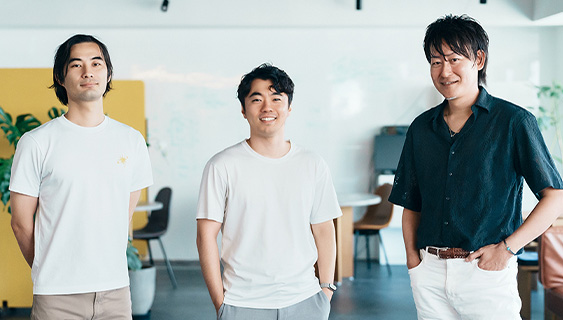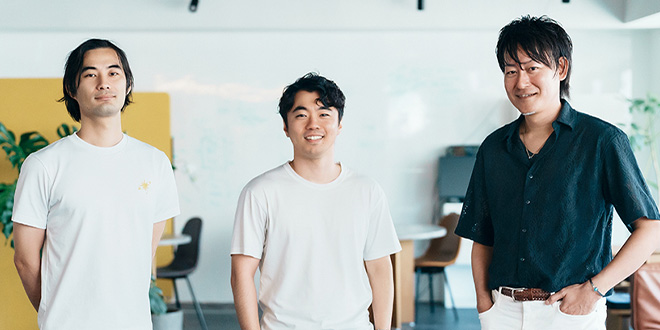Please select your location and preferred language where available.
Promoting boundless data sharing with Kioxia and EAGLYS:
The promise of secure computation


November 10, 2023
Secure computation technology allows private data concerning individuals and companies to be collected and utilized without compromising any confidentiality. The adoption of this technology is expected to bring about new collaborations between companies and industries as well as an increased focus on privacy based on the idea that individuals should have the power to manage their own data. How will the ability to collect and analyze confidential, encrypted information change how business and research are conducted in the future? Yasuhito Yoshimizu of Kioxia’s Institute of Memory Technology Research and Development sits down to discuss the potential of this technology with Hiroki Imabayashi and Yusuke Maruyama of EAGLYS Inc., a trailblazing company in the field of fully homomorphic encryption (FHE).
Contents
What is fully homomorphic encryption?
Imabayashi (EAGLYS): Right now, there is an expectation that businesses breaking new ground in B2B and B2C services will make use of confidential data—such as personal information and trade secrets—to improve the quality of their services and products. For example, there is a growing push for the use of AI in the medical field to assist physicians with diagnoses and bring about personalized medicine; however, as long as there are gaps in the measures used to protect and secure people’s personal information, neither businesses nor consumers feel comfortable allowing their data to be used in such a way. This feeling is only natural, so we have been looking at secure computation as a way to alleviate these risks.

With secure computation, it is possible to search through and process data without needing to decrypt it. Although encryption has traditionally protected data only while it is being transmitted or stored, secure computation allows it to remain encrypted even while it is being accessed - whether for analysis, AI learning, or any other purpose. This reduces the risk of data breaches and misuse.
Maruyama (EAGLYS): There are several types of secure computation, but the focus of the current research and development is on secret sharing and homomorphic encryption. In secret sharing, data is secured by dividing it into meaningless fragments distributed across multiple servers, which can coordinate to complete operations on the still-encrypted data. However, the use of multiple servers does introduce some disadvantages, namely the need for a more complex system architecture as well as a vulnerability to collusion between servers. The other field of focus - homomorphic encryption - also allows operations to be performed on encrypted data without it ever being decrypted, but it does so while only needing one server. The confidentiality of the data is assured as long as the keys are protected - with the one drawback being that it is computationally very intensive. To reduce complexity, current solutions rely on a number of innovations such as single instruction, multiple data (SIMD) operations and hybrid approaches utilizing elements of both secret sharing and homomorphic encryption. However, these hybrid solutions are in many ways inconvenient in that they can only be applied to certain processes, limiting the types of systems that we can construct.

Imabayashi: At EAGLYS, we are aiming to make fully homomorphic encryption (FHE) practical for use in secure computation because we believe that it can be used to address these concerns.
FHE can support a variety of operations in a secure cloud computing environment for encrypted data; on top of this it can be used for a wide range of applications, such as sharing data between different organizations or individuals, outsourcing computations to outside entities, and performing encrypted searches or data analysis within databases.
Maruyama: When it comes to FHE, the challenge is its computational complexity. Because the operations needed to process encrypted text are so complex, the computations are very intensive, and each process inevitably takes a long time to run. To give you an idea, an operation that takes one second to process in plain text might take as much as six hours with encrypted text; our collaboration with Kioxia is aimed at addressing this complexity.
Yoshimizu (Kioxia): That’s why Kioxia and EAGLYS signed a joint development agreement last year with the aim of making secure computation more efficient. By combining the technologies of our two companies we hope to bring together all of the hardware and software necessary to conduct proof-of-concept tests of solutions aimed at speeding up secure computation.

This all started with one of my colleagues, who learned about FHE in Silicon Valley. I was interested to see who was working on it in Japan, and my research led me to EAGLYS. Through our discussions, I concluded that this encryption technology will drive a massive increase in data volumes; and if society reaches the point where all data is encrypted, it will represent an opportunity for Kioxia’s market reach to expand exponentially; however, we agreed that computational complexity would be an issue.
My discussions with the two of you showed me how FHE could be a benefit to society as well as an opportunity for Kioxia to not only boost sales of our flash memory but also to lend our expertise in technological development; and that was the start of our joint development project.
Maruyama: The first time you came to our office, you said, “Our interest in FHE is strictly due to its ability to increase data volumes.” I was honestly impressed to meet someone who thinks this way. I remember that Wwhen I told you that I wanted a GPU the size of a tatami mat [about 90 x 180 cm], you responded excitedly, “That’s what I wanted to hear!” We had a serious discussion about how to create something that others see as unthinkable, and I came away with the impression that you were utterly unlike the businesspeople I usually associate with.
A new type of computer
Yoshimizu: The thing is, we really do want to create a tatami-sized GPU. To be honest, Kioxia’s current core products—like SSDs and flash memory—won’t be all that helpful in realizing the kind of computer you want to create. We won’t be able to make it happen unless we also develop a variety of peripheral technologies. In other words, you’ve presented us with an idea that’s a challenge for us as well.
Imabayashi: We aren’t trying to develop a versatile, general-purpose computer but one specialized in processing specific types of data. The best computer for processing plain text data isn’t going to be the best computer for processing encrypted text. After all, a piece of data that takes one bit to send as plain text may require 4000×32 bits to send as encrypted text. For that reason, if for no other, we need entirely different circuits than in an ordinary computer.

In contrast to today’s computers, which are designed for general-purpose data processing, we want to create a powerful computer able to single-handedly manage all of the tasks of a project—genome analysis, for example—in a secure pipeline incorporating everything from storage to computing. In fact we are starting to see demand for similar computing environments already.
If I were to ask someone to upload their own genomic data or confidential corporate information to one of the many cloud services available today, I wouldn’t be surprised if they were reluctant to do so. While there are potential benefits to increasing data coordination between companies such as supply chain optimization, at present there is no single “box” into which companies would want to store their data along with many other companies’.
The kind of computer we are designing will be indispensable for projects that require unique insights that can only be revealed by analyzing a vast range of data—things that cannot be discovered by referencing the data of just one company or individual.
Maruyama: In traditional computer architecture, privacy protection is built on trust. For example, people might feel more comfortable giving information to a company because it is large, or because they have a history of doing business together. But building such trust is rather difficult and time-consuming, and the risk of revealing valuable information - such as that which could bankrupt a company if it were to leak - is too great for companies to rely solely on trust. That’s why we are trying to integrate both software and hardware to develop a mechanism for privacy protection that is independent of trust.
Yoshimizu: The advantage of Kioxia’s storage technology is its adaptability to major trends in data utilization. To respond to these trends, it is important for us to not only sell products such as SSDs and flash memory but also to accurately understand the inherent value of data. For example, it’s possible to create a large language model by training a generative AI such as ChatGPT on an infinite amount of data, but to do that you would need the storage and computing power to process huge quantities of data at high speed. FHE is the same sort of thing with very few players apart from EAGLYS, and it allows us to play to Kioxia’s strengths. If we strike now, we can seize this business opportunity.

Obstacles to social implementation
Imabayashi: The field of secure computation—especially in relation to FHE—is attracting a lot of attention globally, with big tech companies like IBM, Microsoft, and Google continuously investing more into research, and even the US Department of Defense is making investments in this area. This has resulted in a lot of open-source development, but I’m not aware of any actual instances where secure computation has been implemented on a business level. Even when a company talks about their use cases, they’re mostly hypothetical; it’s as though they are waiting for others to create actual use cases for them. This is one reason why this field is hard to understand and doesn’t attract as much attention as it deserves - considering that it has the potential to shape the social infrastructure of the future. Just as Bitcoin brought attention and anticipation of blockchain technology to the general public, we need real-world applications to boost the profile of secure computation and FHE.
Yoshimizu: However, it’s not as though they haven’t received any attention. For example, a panel of experts with Japan’s Cabinet Office released a statement encouraging the use of secure computation in materials informatics—another field that you’re working on at EAGLYS.
Imabayashi: Of course, decision-makers are naturally concerned about their return on investment, so we can’t just present them with a computer or library and leave them to it. I think it’s important to always begin the discussion by laying out the technology’s applications, or use cases, to give an idea of how it can be implemented in the customer’s business and the kinds of transformations that will occur once it becomes widespread in their industry.
Maruyama: Exactly. I hope that people from different industries will come together out of the desire to explore the interesting implications of this technology, just like Kioxia is doing with us right now. I also hope that such a consortium would attract investment in the field, thereby driving even more interest. Speaking of which, I want to tell you about a promising idea I had. I call it the Eavesdropping App...
Yoshimizu: The first time you mentioned this, I thought, “What a terrible name!”

Maruyama: Maybe, but I think the name makes it easy to understand what secure computation can bring to the world. So, it’s the name I’m going with for now. [Laughs.] Specifically, this would be an app with which you make voice recordings on your phone. No one anywhere on Earth—even yourself—would be able to listen to the recordings, but you could run analyses on them and view the results.
It’s already become common for people to monitor their health - by using their smartphone or smartwatch to track their pulse rate and time spent asleep. But really, you would need a more diverse data set to get an accurate understanding of your health. It’s thought that an analysis of a person’s speech, for example, could be an important medical indicator for early detection of dementia or Alzheimer’s.
But there is no way to collect that kind of data continuously, say, by recording someone’s speech throughout the day. After all, it would be a serious invasion of privacy to have everything someone says, and everything said to them, recorded 24 hours a day and then analyzed by someone in an office somewhere. But with FHE technology, that voice data could be analyzed in encrypted form, without anyone being able to read the data or decrypt it. On the basis of the analysis alone, a specialist—or possibly a medical AI—could pick up on the user’s symptoms at an early stage.
The encrypted data could never be accessed, even with the aid of a program, but it can still be analyzed. If you’re confident that the only thing anyone would ever see is the analysis result, would you still worry about your phone being bugged, so to speak? It’s like a positive form of eavesdropping. I think that if people can use a smartphone app to record information about themselves—with the guarantee that their privacy will be absolutely protected and the information will be used only for their own benefit—we will be able to collect more data and expand the ways in which it can be analyzed.
Imabayashi: It’s a clever idea, and it may be feasible one day. But still, it would be better to change the name [laugh]. In a way, the smartphone is a kind of modern-day eavesdropping device in that it is equipped with GPS technology that tracks our every move—but this technology has expanded our mobility. And now, it’s equipped to collect even more information, related to our lifestyles and healthcare. If you think about it that way, “eavesdropping” starts to sound like a good thing!
A future brought about by connected data
Imabayashi: There is no doubt in my mind that the big data kept by various industries—including data that has gone unused until now—will be a springboard for social reform and individual wellbeing.
“It is probably easiest to understand the value of big data in the medical field. For example, the growth in remote work due to the pandemic has led to an increase in the number of people complaining of lifestyle diseases and mental health symptoms. However, it is rare for a patient to consult with a specialist in lifestyle diseases; generally, they make an appointment with whichever doctor is available when they’re free. As a result, there has been a rise in misdiagnoses.

AI-based support could be a solution to this problem, but an AI cannot make an accurate assessment if it doesn’t have enough data. Meanwhile, it is very much against the law to take someone’s personal data outside of a medical institution, and it is still not feasible to combine data from different medical institutions.
However, because FHE covers everything from storage to computing, it would be possible to have an AI analyze data in a hidden or encrypted state and show only the results to everyone involved. This would not only reduce the likelihood of misdiagnosis, it might also lead to the development of new drugs if the data were to be shared with pharmaceutical companies. Eventually, it could even lead to the creation of an infrastructure for personalized medicine.
Yoshimizu: It’s easy to imagine applications in healthcare, including solutions that are already in place today. I believe that the combination of personal data and diagnostic data will enable analyses of immeasurable value.
For example, if you’re using genetic analysis to investigate the causes of a rare disease, might be able to collect the genomic data of 500 people by getting their approval on an individual basis, but it would be practically impossible to gain access to a data set of 100 million people.
Without this wider data set, the best that researchers can do is determine one’s susceptibility to certain adult-onset diseases. But with data on 100 million people, they may be able to determine the causes of even the rarest diseases. Of course, this is physically impossible to do currently, but this is precisely the kind of case in which FHE could come in handy.

Imabayashi: Acquiring unprocessed or original information - the so-called primary information - is obviously costly in terms of both time and money, but the use of FHE would cut costs dramatically and even make it possible to utilize data more thoroughly than ever. While generative AIs like ChatGPT are trained on secondary and tertiary information that is available on open platforms like Google, I believe that the race for effective data analysis will be won by the first individuals and industries to effectively use primary information—instead of the data we currently depend on.
Maruyama: It will be some time before primary information can be utilized in the medical field, but EAGLYS has already begun providing similar services to chemical and materials manufacturers.
Our Alchemista service provides chemical manufacturers with the ability to encrypt and publicize their proprietary materials data. For materials manufacturers, it allows test results and other data from product manufacturers to be encrypted and sent to the materials manufacturer.
As a result, chemical and materials manufacturers can promote the value of their materials, create new business opportunities, and engage in closer collaboration and joint development with other companies and research institutions. For these third parties, such close collaboration makes it easier for them to determine the best materials for their needs. In short, Alchemista helps to maintain the confidentiality of proprietary data even as it’s used to select the optimal material for a given purpose.

Yoshimizu: What I enjoy about working with the two of you is that we can bounce ideas off of each other. I often start with a very basic framework, but I don’t often get to see so many great ideas getting added to that framework to give it shape and momentum.
The first stage of our two companies’ collaboration is a combination of hardware and software, and it will take shape by the end of 2023. It will be FHE in the truest sense, a very high-level platform, and I think we will be able to deliver it earlier than anybody else.
As you mentioned earlier, Hiroki, it will be important to create use cases and communicate them to the wider world, rather than just showing off a computer and a library and calling it a day. I would like to first focus on the chemical industry and achieve concrete results in the field of materials informatics - the field that Yusuke just briefly talked about - and then attempt to implement FHE in the medical field.
Imabayashi: For both of our companies, memory and data utilization are areas with the greatest potential for synergy - therefore it is exciting to work on something that blends the dreams of both EAGLYS and Kioxia. I think that together, we will develop the kind of technological innovation that will take us into a future which we at EAGLYS could not have envisioned on our own.
I am invigorated by the continued support of Kioxia, and also we are confident that this collaboration will take us into a whole new world.
The content and profile are current as of the time of the interview (July 2023).


